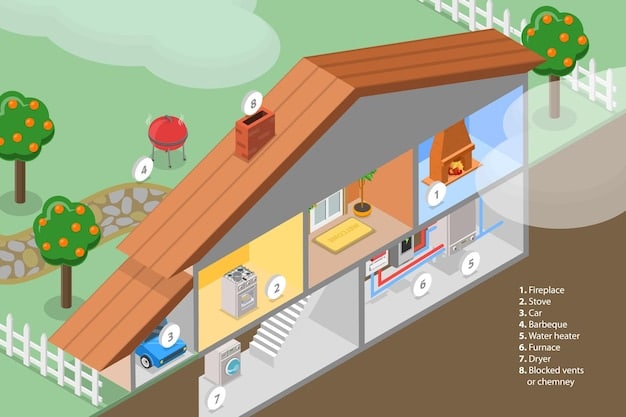Harvest Rainwater: Cut Water Bills by 10% for Sustainable Living

Harnessing rainwater provides an effective and environmentally conscious approach to significantly lowering household water expenses, with the potential to reduce utility bills by at least 10% through simple collection and utilization systems.
In an era where sustainability increasingly intertwines with economic prudence, the ancient practice of rainwater harvesting offers a compelling solution for modern households. Imagine a world where dependency on municipal water supplies is significantly reduced, where every downpour becomes an opportunity to lower expenses and contribute to a healthier planet. This article delves into the transformative potential of Rainwater Harvesting: Collect and Use Rainwater to Reduce Your Water Bill by 10%, exploring how this accessible method can lead to tangible savings and foster a more resilient, eco-friendly lifestyle.
Understanding the Fundamentals of Rainwater Harvesting
Rainwater harvesting, at its core, is the simple act of collecting and storing rainwater that falls on surfaces, typically rooftops. This collected water can then be used for various purposes, from irrigation to non-potable indoor uses, effectively reducing reliance on treated municipal water. The concept is ancient, but its revival is driven by contemporary concerns over water scarcity, rising utility costs, and the desire for greater environmental stewardship.
The fundamental components of a basic rainwater harvesting system are relatively straightforward. It begins with a collection surface, usually a roof, designed to channel rainwater. From there, the water flows into gutters and downspouts, which direct it to a storage container. This container can range from a simple rain barrel to a sophisticated underground cistern capable of holding thousands of gallons. The design and complexity vary widely based on individual needs, local regulations, and the intended use of the water.
Types of Rainwater Harvesting Systems
There are generally two main types of systems, each tailored to different scales and applications. Understanding these can help you determine the best fit for your property and water usage needs.
- Wet Systems: These systems involve pipes that remain filled with water, even when it’s not raining. The downspouts connect to underground pipes that lead to the storage tank. When it rains, new water pushes the old water into the tank. This design is less prone to blockages but requires more meticulous installation to prevent stagnant water issues.
- Dry Systems: In contrast, dry systems are designed so that all the downspout pipes drain completely after a rain event, delivering the collected water directly to the storage tank. This prevents water from sitting in the pipes, reducing the risk of bacterial growth and odors. They are generally simpler to install and maintain for residential use.
Beyond these basic system types, filtration and treatment mechanisms can be added, depending on the water’s intended purpose. For non-potable uses like gardening, minimal filtration is often sufficient. However, for indoor applications or extensive garden use, more advanced filtration, including first-flush diversions and sediment filters, becomes crucial to maintain water quality and system efficiency.
Designing Your Efficient Rainwater Collection System
Effective design is key to maximizing your rainwater harvesting potential and achieving that 10% reduction in your water bill. It involves assessing various factors, from your roof’s capacity to local rainfall patterns and your household’s water demand. A well-designed system not only collects water efficiently but also integrates seamlessly with your property’s aesthetics and functionality.
The first step in planning is to calculate your potential harvest volume. This involves a simple formula: roof area (in square feet) multiplied by rainfall (in inches) multiplied by 0.623 (a conversion factor for gallons). This calculation provides an estimate of how many gallons you can realistically collect from a given rainfall event. Factor in historical rainfall data for your area to get a more accurate long-term projection. Understanding this potential helps in sizing your storage tank appropriately and avoiding over or under-capacity issues.
Key Components and Installation Considerations
Each component plays a vital role in the overall efficiency and longevity of your system. Careful selection and professional installation can prevent common problems and ensure a smooth operation.
- Roof Surface: Most roof types are suitable, but certain materials like asphalt shingles can release small amounts of particulates. Metal or tile roofs are generally preferred for cleaner water collection.
- Gutters and Downspouts: Ensure they are clean, properly sloped, and securely attached. Oversize gutters might be beneficial in areas with heavy rainfall to prevent overflow.
- First-Flush Diverter: This essential device prevents the initial, dirtiest runoff from entering your storage tank. It diverts the first few gallons of rain, which contain dust, leaves, and other debris accumulated on the roof, ensuring cleaner water collection.
- Storage Tank (Cistern/Barrel): The size should match your calculated potential harvest and water demand. Consider materials like food-grade plastic, fiberglass, or concrete. Placement should be on a stable, level surface, away from direct sunlight to inhibit algae growth.

Ventilation and overflows are crucial for system health and safety. Adequate ventilation prevents anaerobic conditions and odors, while an overflow mechanism is necessary to safely manage excess water during heavy downpours, preventing damage to your property. Regular maintenance, such as cleaning gutters and inspecting filters, will ensure your system operates at peak efficiency year-round.
Maximizing Savings: Where to Use Harvested Rainwater
The true financial benefit of rainwater harvesting comes from its strategic utilization. By identifying areas where municipal water is commonly used, you can substitute it with free, naturally collected rainwater, directly impacting your utility bill. The goal is to displace as much potable water consumption as possible without compromising convenience or hygiene.
Outdoor irrigation is perhaps the most common and immediate application for harvested rainwater. Lawns, gardens, and potted plants thrive on rainwater, which is naturally soft and free of chlorine and other chemicals found in treated tap water. Using a hose connected to your rain barrel or a more elaborate drip irrigation system powered by a cistern can significantly reduce your outdoor water usage, especially during dry spells or peak growing seasons. This alone can account for a substantial portion of the 10% bill reduction target.
Indoor Non-Potable Applications
Moving beyond outdoor use, harvested rainwater can be safely and effectively used for several indoor, non-potable applications, provided adequate filtration is in place. These uses can lead to even greater savings.
- Toilet Flushing: Toilets consume a significant amount of household water. Connecting your harvested rainwater system to your toilet cisterns can drastically reduce your potable water consumption without requiring extensive treatment.
- Laundry: Rainwater is naturally soft, meaning you’ll need less detergent for your laundry, and your clothes may feel softer and last longer. A separate, dedicated connection to your washing machine is typically required for this application.
- Car Washing: Instead of using a metered outdoor spigot, wash your car with collected rainwater. This is an easy way to conserve and save money, especially if you wash your vehicle frequently.
For any indoor application, it is paramount to ensure proper plumbing segregation to prevent cross-contamination with the potable water supply. Many jurisdictions have strict codes regarding these installations, often requiring backflow prevention devices and clear labeling of non-potable lines. Consulting with a qualified plumber experienced in rainwater systems is highly recommended to ensure compliance and safety. Employing these strategies effectively positions your household to achieve and surpass the 10% water bill reduction target, transforming a natural resource into tangible financial savings.
Addressing Common Concerns and Regulations
While the benefits of rainwater harvesting are clear, prospective users often have valid concerns regarding safety, water quality, and legalities. Understanding and addressing these points is crucial for a successful and compliant system. The primary concern is always water quality, especially if the water is to be used for anything beyond immediate outdoor irrigation.
Many people wonder about the purity of rainwater. While generally clean when it falls, it can pick up contaminants from the roof surface, atmospheric pollutants, or storage containers. For non-potable uses like gardening or toilet flushing, basic filtration (like a leaf screen and first-flush diverter) is often sufficient. However, for any potential human contact, such as laundry, or even more so for drinking, advanced filtration and purification systems (including UV sterilization or chemical treatment) become necessary. Regular testing of water quality, especially for indoor uses, is a recommended practice to ensure safety.
Legal and Health Considerations
Navigating the regulatory landscape is an important step before installing a system. While many states and municipalities in the US encourage rainwater harvesting, specific regulations can vary widely, and some areas may have restrictions.
- Local Ordinances: Check with your local city or county planning department. Some areas may require permits for certain system sizes or types, particularly if they involve connections to indoor plumbing. Some states have specific guidelines or incentives.
- Health Officer Consultation: If you plan to use water indoors, especially for laundry or other uses involving human contact, consult your local health department. They can provide guidance on necessary filtration, backflow prevention, and water testing protocols to ensure public health is protected.
- System Maintenance: Regular cleaning of gutters, screens, and tanks is vital to prevent mosquito breeding, algae growth, and bacterial contamination. A well-maintained system yields cleaner water and prevents potential health hazards.

For example, states like Texas, Oregon, and Washington have actively promoted rainwater harvesting through legislation and incentives, while others may have more restrictive codes or require specific permits. Always verify local stipulations to avoid potential legal issues or fines. By proactively addressing these concerns, you can ensure your rainwater harvesting system is not only efficient but also safe and fully compliant with all relevant regulations.
The Environmental and Economic Benefits Beyond Savings
While the direct monetary savings on your water bill are a compelling advantage, the broader environmental and economic benefits of rainwater harvesting extend far beyond the direct reduction of expenses. Embracing this practice contributes to a more sustainable lifestyle and offers community-wide advantages.
From an environmental perspective, collecting rainwater significantly reduces the strain on municipal water supplies and natural aquifers. This is particularly crucial in regions experiencing drought or water scarcity, where every gallon diverted from the central supply lessens the pressure on dwindling resources. Moreover, it helps mitigate urban stormwater runoff. Instead of rain overwhelming drainage systems and contributing to erosion or pollution of local waterways, it is captured for beneficial use. This reduces the amount of pollutants flowing into rivers and lakes, improving overall water quality in your local ecosystem.
Long-Term Sustainability and Community Impact
The practice also fosters a greater sense of water independence and resilience. In the face of infrastructure challenges, natural disasters, or rising water costs, households with harvesting systems have a partial, if not complete, alternative water source, enhancing their self-sufficiency.
- Reduced Infrastructure Load: By reducing peak demand on public water systems, rainwater harvesting can alleviate the need for costly expansions of municipal water treatment plants and distribution networks. This can translate to lower taxes and utility infrastructure costs for the entire community.
- Lower Carbon Footprint: Treating and pumping municipal water consumes a significant amount of energy. By using self-collected rainwater, you reduce the energy associated with water delivery, lowering your household’s overall carbon footprint and contributing to climate change mitigation efforts.
- Healthy Landscapes: As mentioned, rainwater is naturally soft and free of chemicals, making it ideal for plants. Gardens watered with rainwater often thrive, leading to healthier, more vibrant landscapes that require fewer additional supplements.
Economically, beyond the immediate bill savings, implementing rainwater harvesting can also increase property value, particularly in areas where water conservation is highly valued or water is a premium. It signals a commitment to sustainability and a practical approach to resource management. These multifaceted benefits underscore why rainwater harvesting is not just a personal saving strategy but a meaningful contribution to environmental health and community resilience.
Future-Proofing Your Home with Rainwater Harvesting
As climate patterns shift and populations grow, the demand for potable water is expected to increase, making water conservation practices more critical than ever. Rainwater harvesting positions your home to be more resilient and adaptable to future environmental and economic challenges. It moves beyond a simple cost-saving measure to become an integral part of sustainable home management.
Integrating rainwater harvesting into your home’s infrastructure is an investment in long-term sustainability. It prepares you for potential water restrictions, price hikes, or even disruptions to municipal water services. By reducing your reliance on external water sources, you gain a degree of independence that offers peace of mind and operational flexibility. This forward-thinking approach makes your property more self-sufficient and attractive in a world increasingly valuing eco-conscious living.
Smart Technologies and Advanced Systems
The evolution of technology continues to enhance the efficiency and convenience of rainwater harvesting. Modern systems can incorporate automated controls and monitoring to optimize collection and usage.
- Automated Diverters: Advanced first-flush systems can be programmed to divert specific volumes or based on water quality sensors, ensuring only the cleanest water enters storage.
- Smart Monitoring: Sensors can monitor tank levels, pump status, and even trigger alerts for maintenance needs or low water levels, allowing for more proactive management and ensuring continuous supply.
- Integrated Home Systems: For new constructions or major renovations, rainwater harvesting can be fully integrated with existing plumbing and smart home systems, creating a seamless and highly efficient water management solution.
Exploring these advanced options can further optimize your rainwater harvesting system, turning it into a truly smart and sustainable asset for your home. This capability to adapt and incorporate new technologies ensures that your investment continues to yield benefits, contributing not just to immediate savings but to the long-term well-being of your household and the planet.
| Key Point | Brief Description |
|---|---|
| 💧 Bill Reduction | Harvesting rainwater can directly lower your water bill by 10% or more. |
| 🌱 Eco-Friendly | Reduces strain on municipal supplies and mitigates stormwater runoff. |
| 🏡 Home Value | Increases property self-sufficiency and market appeal in sustainable communities. |
| 💡 Versatile Use | Suitable for gardening, toilet flushing, and laundry, extending savings beyond outdoor use. |
Frequently Asked Questions About Rainwater Harvesting
▼
While rainwater is pure at falling, it can pick up contaminants from roofs and storage. For potable use, advanced filtration, purification (like UV treatment), and regular testing are crucial to ensure it meets drinking water standards, which often requires a dedicated system and adherence to health guidelines.
▼
A basic system typically includes a collection surface (roof), gutters and downspouts to channel water, a first-flush diverter to remove initial debris, a leaf screen to prevent large particles from entering, and a storage container such as a rain barrel or cistern. Pumps may be added for pressure.
▼
Many households can achieve a 10% reduction or more, especially by using collected rainwater for outdoor irrigation and non-potable indoor uses like toilet flushing. Actual savings depend on roof size, rainfall, storage capacity, and your household’s current water consumption habits.
▼
Regulations vary widely by state and local jurisdiction. While once restricted, many areas now encourage rainwater harvesting and offer incentives. Always check with your local city or county planning and health departments for specific permitting requirements, building codes, and usage restrictions in your area.
▼
Key maintenance tasks include regularly cleaning gutters and downspouts, inspecting and cleaning leaf screens and first-flush diverters, and periodically cleaning your storage tank to prevent sediment buildup, algae, and mosquito breeding. Seasonal checks are often recommended to ensure optimal system performance.
Conclusion
Rainwater harvesting stands as a practical, eco-conscious, and economically beneficial strategy for modern homes. By embracing this age-old practice with modern approaches, households can significantly reduce their reliance on municipal water sources, leading to tangible savings on utility bills—often exceeding the targeted 10%. Beyond the financial incentives, it fosters environmental stewardship by lessening the burden on natural water reserves and mitigating stormwater runoff. As we navigate a future with increasing demands on precious resources, adopting rainwater harvesting is not merely a choice for today but a sustainable investment for tomorrow, empowering homes to be more resilient and environmentally aligned.





